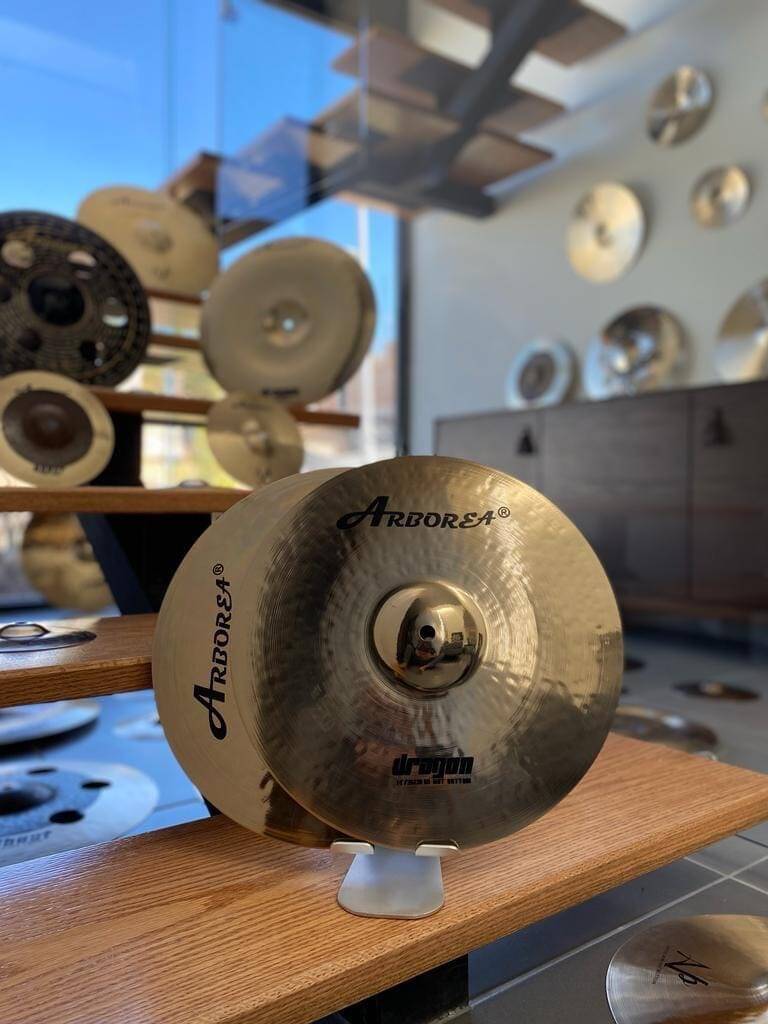The Chinese cymbal, also known as the China cymbal, is a type of cymbal that originated in China and has been used in various forms of music for thousands of years. These cymbals are characterized by their unique shape, featuring an upturned or downturned edge and a distinctive sound that is often described as “trashy” or “explosive.”Chinese cymbals have a rich history that dates back to ancient times. The earliest known cymbals were developed in China around 3000 BCE, coinciding with the emergence of bronze-working techniques. These early cymbals were primarily used in religious and ceremonial contexts, serving as important instruments in Buddhist and Taoist rituals.

| Key Information: Chinese Cymbals | |
|---|---|
| Origin | China, circa 3000 BCE |
| Traditional Materials | Bronze alloy (copper and tin) |
| Common Sizes | 8″ to 27″ diameter |
| Characteristic Features | Upturned or downturned edge, conical or cylindrical bell |
| Traditional Uses | Religious ceremonies, military signaling, theatrical performances |
| Modern Uses | Various music genres, especially rock, metal, and jazz fusion |
| Notable Manufacturers | Wuhan, Zildjian, Sabian, Paiste |
The evolution of Chinese cymbals from ancient ritual instruments to modern musical staples is a fascinating journey. In ancient China, cymbals were not just musical instruments but also held significant symbolic and spiritual importance. They were often used in pairs, clashed together to create a loud, attention-grabbing sound that was believed to ward off evil spirits and bring good fortune. As trade routes expanded and cultural exchanges increased, Chinese cymbals began to make their way westward. By the 17th century, these exotic instruments had caught the attention of European composers and musicians. Nicolaus Strungk’s use of cymbals in his 1680 opera marked a significant milestone in their integration into Western classical music. However, it wasn’t until the late 19th and early 20th centuries that Chinese cymbals truly began to find their place in Western music. The rise of jazz and the development of the modern drum kit provided new opportunities for these unique percussion instruments. Early jazz drummers, always on the lookout for novel sounds, embraced the distinctive “trash” of Chinese cymbals.The real turning point for Chinese cymbals came with the advent of rock music in the 1960s and 1970s. As drummers sought ways to cut through increasingly loud amplified instruments, the piercing, explosive sound of Chinese cymbals became highly desirable. Manufacturers like Paiste responded to this demand with innovations like the Giant Beat series in 1965, which helped pave the way for the widespread use of Chinese cymbals in rock music. One of the most distinctive features of Chinese cymbals is their shape. Unlike traditional Turkish-style cymbals with their gradual bow and rounded bell, Chinese cymbals typically have a more dramatic profile. They often feature a conical or “square” bell, a flatter bow, and the characteristic upturned or downturned edge. This unique construction contributes to their complex, trashy sound with a rapid attack and decay. Chinese cymbals come in various types, each with its own characteristics:
- Traditional: These have a conical bell and an unfinished, rough surface on the underside.
- Novo: Developed by Paiste, these combine the Chinese cymbal profile with a rounded bell and reversed edge, producing a darker, more aggressive sound.
- Pang and Swish: Originated by Zildjian, these cymbals blend Chinese and Turkish characteristics for a more controlled sound.
- China Splash: Smaller versions (usually up to 12″) that provide quick, trashy accents.
- Rocktagon: A Sabian creation, this octagonal cymbal produces a sound between a crash and a China cymbal.
The versatility of Chinese cymbals has led to their adoption across various musical genres. In rock and metal, they’re often used for explosive accents and dramatic effect. Jazz fusion drummers appreciate their complex overtones and quick decay for adding color to their playing. Even in orchestral settings, Chinese cymbals can be found adding their unique voice to percussion sections. Modern cymbal makers continue to innovate with Chinese cymbal designs. Companies like Zildjian, Sabian, and Paiste offer a wide range of sizes and variations, from tiny splashes to massive 27-inch models. However, for those seeking a more traditional sound, Wuhan cymbals from China still offer an authentic, handcrafted option that harkens back to the instrument’s roots. The manufacturing process of Chinese cymbals has evolved over time, but many traditional techniques are still employed. The cymbals are typically made from a bronze alloy, with the metal being heated, hammered, and shaped to achieve the desired profile and sound characteristics. The uneven, hand-hammered surface contributes to the complex overtones that Chinese cymbals are known for.In recent years, there has been a resurgence of interest in vintage and traditional cymbal sounds. This has led to increased appreciation for the unique qualities of Chinese cymbals, not just as effect cymbals but as integral parts of a drummer’s setup. Some drummers, like Terry Bozzio, have even created entire setups using primarily Chinese cymbals, demonstrating their versatility and musical potential.The history of Chinese cymbals is a testament to the global nature of musical evolution. From ancient Chinese temples to modern recording studios, these instruments have traveled across continents and centuries, adapting to new musical contexts while retaining their distinctive character. As drummers continue to seek new sounds and expressions, Chinese cymbals remain an important tool in their sonic arsenal, bridging the gap between ancient traditions and contemporary musical innovation.
